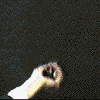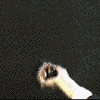The following article was inserted in the program at the world premiere performance of Randy Hostetler’s P[l]aces last Tuesday, January 13, Music At The Anthology, NYC. I thank Rico Apriori for his suggestion that I post this here – it gives an overview of the process by which the piece was reconstructed. Thank you, all of you who were present at the concert and those who helped me along the way. I could not have accomplished it without your help and support.
The Reconstruction of Randy Hostetler’s P[l]aces by Lisa Bielawa
When I first arrived at Yale, Randy Hostetler was a legend among the students. He had already left for CalArts, but he had been the musical director of the a cappella jazz group which I joined, Redhot & Blue, and many of the arrangements of jazz tunes which we sang were written by him. Long before I actually met Randy, I used to use the name “Hostetler” in my diary as a general noun, meaning “any piece of music which is virtuosic, difficult and beautiful.” (“I want to try to write a real Hostetler this time…”) We finally met and got to know each other through reunions, and had only just begun a friendship when he died.
In April, 1997, I met Zona and Jim Hostetler, who invited me to perform on a concert in Randy’s memory in Washington, D.C. While I was there I discovered P[l]aces in all of its various forms: a cryptic, oversized “score” on graph paper with colored pencils, from which he conducted the reading; videotapes of rehearsals and readings; one computer-scored page entitled “Lamp Groove” with handwritten black and white circles over the notes. After extensive searching, Zona was able to send me a cassette of excerpts from the songs which Randy quoted in the piece, and computer disks with around 45 different files, all in Professional Composer, an obsolete notation program which ran on the Macintosh Classic series computers of the 1980’s. After giving myself a refresher course in ’80’s computer technology, I dug out my Mac Classic and looked at the files. He had completed parts and had begun work on a score, but the score fell off at measure 92. Zona found one printed part from the reading (Percussion 3, the marimba part) with handwritten circles, and by watching the videotape with this part in hand, I learned that the black circles indicated “lamp off” and the white circles, “lamp on.” In this way I was able to restore all of the lamp indications to the other parts, which I printed out from the old files.
In order to begin work on the score, I performed two “translations” on the files. First I saved them as “standard MIDI” files, which translates all of the visual pitch and rhythmic information into sound files which any modern notation program can decode. Then I moved to my Power Macintosh computer and opened these sound files into the scoring program Finale. I edited these newly-imported files against the printouts I had made, then little by little, I added each part into a score template. As the score grew, I began to see the structures in the piece emerge: I discovered that the piece was polymetric, with different players in 3/4 and 4/4 at the same time. I added a staff for the Timekeeper, for whom a part had never been created. His part consists of a 3-against-4 pattern which remains the same rhythmically throughout the piece but undergoes numerous metrical transformations in relation to the other players. I also began to see a layering of the musical quotes from the tape of excerpts which Zona sent me.
After the score was complete, I needed to identify the sounds which were generated by the MIDI drums, including an 8-second rap excerpt which is triggered five minutes into the piece and locks into the Timekeeper’s right-hand tempo. From the videotape I was able to identify a general contour and rhythm of the rapper’s voice, but not the words. I combed through the various tracks from Public Enemy albums which Randy listed as source material until I found the matching eight seconds, then noticed that although Randy had chosen a segment with ad-libbed vocal banter, the lyrics elsewhere in the same song addressed the issue of “stealing” creative material from other sources: “I found this mineral that I call a beat…They say that I sample, They say that I stole this, Can I get a witness?” In fact, the musical stuff of P[l]aces, which is quite independent of the piece’s sophisticated polymetric structure, is made up almost entirely of borrowed segments authored by the songwriters Randy admired: Johnny Cash, Rare Essence, Public Enemy, Bob Marley, Mongo Santamaria, Poncho Sanchez, Louis Armstrong, Nino Rota, and Jimmie Lunceford. One can sense in his project a fascination with the issue of musical ownership: through this piece we can learn how Randy heard the music he loved. In this scenario one becomes focused on the receptive nature of the creative mind. These segments do not always appear in their entirety, but they never undergo any transposition, rhythmic alteration or thematic development. Even the segments whose original source is Randy’s own sketches – his 12/8 groove or his “slow waltz” – rigorously maintain their integrity throughout the piece. The visual art world has seen several movements in which borrowed material is central, from the “ready-made” art of Dada and the cubists’ collages in the early part of the century to the “Appropriation Art” of the 1980’s. This use of small, inflexible units in the service of a large-form, abstract structure is also reminiscent of John Cage’s practice of employing highly-organized structures which could be “filled” with chance material. I learned after the score was complete that whenever a segment returns in P[l]aces, its state of fragmentation is determined by a chance operation as well: these values were the result of hundreds of I Ching hexagrams which Randy and his friend Francesca Talenti generated by throwing coins.
Although the overwhelming majority of questions I had in this process were answered by Randy’s friends and family as I worked, there were a few elements which stubbornly remained just out of reach – a sampled sound, a metric modulation which wouldn’t work out quite right mathematically – and in these moments I always went forward in the spirit of play. When I saw the final words of Randy’s own acknowledgements in the program for the reading which took place at CalArts in 1989, I was finally able to let myself find my own solutions: “Thank you Art for letting Alan use your washtub. Thank you Alan for letting Andy use the drill…Thank you everyone else for letting everyone else do everything else.”


